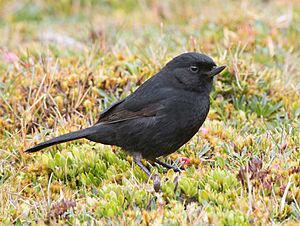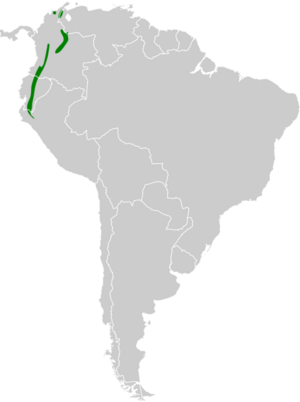Black flowerpiercer facts for kids
Quick facts for kids Black flowerpiercer |
|
|---|---|
 |
|
| Cajas National Park, Ecuador | |
| Conservation status | |
| Scientific classification | |
| Genus: |
Diglossa
|
| Species: |
humeralis
|
 |
|
The black flowerpiercer (Diglossa humeralis) is a small bird found in the mountains of South America. It belongs to the Thraupidae family, which includes many colorful birds like tanagers. This bird is known for its unique beak, which helps it drink nectar from flowers.
You can find the black flowerpiercer in countries like Colombia, Ecuador, Peru, and Venezuela. It prefers to live in high-up places like moist mountains and shrubland areas.
Contents
What Does a Black Flowerpiercer Look Like?
Adult black flowerpiercers are about 13 to 14 centimeters (5 to 5.5 inches) long. They are mostly black all over. Males have a slightly shiny, glossy black color with a hint of blue. Their eyes are brown, and their beaks are black with a gray base.
Female black flowerpiercers are a duller black than males. Their wings and tail might look a bit brownish. Young birds also have a duller color.
Different Types of Black Flowerpiercers
There are a few slightly different types, or subspecies, of the black flowerpiercer. They mostly look similar but have small differences depending on where they live:
- D.h. aterrima: This type is found in Ecuador and southern Colombia. It looks very much like the main description.
- D.h. humeralis: You can find this one in the eastern Andes mountains of Colombia and southwestern Venezuela. Males are dull black with a bluish patch on their shoulders and a small grayish area on their back (rump). Females are very dark brown, and their gray rump is less clear.
- D.h. nocticolor: This type lives in Santa Marta, Colombia, and Perija, Venezuela. It is all black with only a slight shine and a dark gray rump. Females are a bit duller than the males.
What Does a Black Flowerpiercer Sound Like?
The black flowerpiercer makes a rapid series of squeaky trills and twitters. Its song is even faster than that of the glossy flowerpiercer (Diglossa lafresnayii). Some people say its sounds are similar to the cinereous conebill (Conirostrum cinereum).
Where Do They Live?
These birds live in the subtropical zones up to the high-altitude grasslands called Paramo. They are found at elevations between 2,175 and 4,000 meters (about 7,100 to 13,100 feet). Most often, you'll see them between 2,700 and 3,400 meters (about 8,800 to 11,100 feet).
Black flowerpiercers like to live at the edges of dense, wet forests. They can also be found in areas with scattered plants, bushy clearings, eucalyptus tree farms, parks, and even gardens.
How Do They Behave?
Black flowerpiercers mainly eat nectar from flowers, but they also catch and eat small insects. They are very quick and active, especially in the lower parts of the forest. These birds are usually seen alone or sometimes in pairs.
Images for kids




